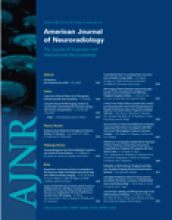OtherPHYSICS REVIEW
Radiation Dose-Reduction Strategies for Neuroradiology CT Protocols
A.B. Smith, W.P. Dillon, R. Gould and M. Wintermark
American Journal of Neuroradiology October 2007, 28 (9) 1628-1632; DOI: https://doi.org/10.3174/ajnr.A0814
A.B. Smith
W.P. Dillon
R. Gould

References
- ↵Kalra MK, Maher MM, Toth TL, et al. Strategies for CT radiation dose optimization. Radiology 2004;230:619–28
- ↵Berrington de Gonzalez A, Darby S. Risk of cancer from diagnostic X-rays: estimates for the UK and 14 other countries. Lancet 2004;363:345–51
- ↵
- Mayo JR, Aldrich J, Muller NL. Radiation exposure at chest CT: a statement of the Fleischner Society. Radiology 2003;228:15–21
- Wiest PW, Locken JA, Heintz PH, et al. CT scanning: a major source of radiation exposure. Semin Ultrasound CT MR 2002;23:402–10
- ↵Aroua A, Burnand B, Decka I, et al. Nation-wide survey on radiation doses in diagnostic and interventional radiology in Switzerland in 1998. Health Phys 2002;83:46–55
- ↵Linton OW, Mettler F Jr. National conference on dose reduction in CT, with an emphasis on pediatric patients. AJR Am J Roentgenol 2003;181:321–29
- ↵Associated Press (July 7, 2005). Low-Dose Radiation Levels Pose Cancer Risk. Available at: http://www.msnbc.msn.com/id/8389834/page/2/. Accessed December 15,2006
- ↵Brenner D, Elliston C, Hall E, et al. Estimated risks of radiation-induced fatal cancer from pediatric CT. AJR Am J Roentgenol 2001;176:289–96
- ↵
- ↵McCollough CH, Bruesewitz MR, McNitt-Gray MF, et al. The phantom portion of the American College of Radiology (ACR) computed tomography (CT) accreditation program: practical tips, artifact examples, and pitfalls to avoid. Med Phys 2004;31:2423–42
- ↵McNitt-Gray MF. AAPM/RSNA physics tutorial for residents: topics in CT–radiation dose in CT. Radiographics 2002;22:1541–53
- ↵
- ↵Hamberg LM, Rhea JT, Hunter GJ, et al. Multi-detector row CT: radiation dose characteristics. Radiology 2003;226:762–72
- ↵Wintermark M, Maeder P, Verdun FR, et al. Using 80 kVp versus 120 kVp in perfusion CT measurement of regional cerebral blood flow. AJNR Am J Neuroradiol 2000;21:1881–84
- ↵Mastora I, Remy-Jardin M, Delannoy V, et al. Multi-detector row spiral CT angiography of the thoracic outlet: dose reduction with anatomically adapted online tube current modulation and preset dose savings. Radiology 2004;230:116–24
- Kalra MK, Rizzo S, Maher MM, et al. Chest CT performed with z-axis modulation: scanning protocol and radiation dose. Radiology 2005;237:303–08
- Mulkens TH, Bellinck P, Baeyaert M, et al. Use of an automatic exposure control mechanism for dose optimization in multi-detector row CT examinations: clinical evaluation. Radiology 2005;237:213–23
- Kalra MK, Maher MM, D'souza RV, et al. Detection of urinary tract stones at low-radiation-dose CT with z-axis automatic tube current modulation: phantom and clinical studies. Radiology 2005;235:523–29
- ↵Namasivayam S, Kalra MK, Pottala KM, et al. Optimization of Z-axis automatic exposure control for multidetector row CT evaluation of neck and comparison with fixed tube current technique for image quality and radiation dose. AJNR Am J Neuroradiol 2006;27:2221–25
- ↵Smith AB, Dillon WP, Lau BC, et al. Successful implementation of a radiation dose reduction strategy for CT protocols in a neuroradiology section. Radiology (in process)
- ↵Kalra MK, Wittram C, Maher MM, et al. Can noise reduction filters improve low-radiation-dose chest CT images? Pilot study. Radiology 2003;228:257–64
- ↵Kalra MK, Maher MM, Sahani DV, et al. Low-dose CT of the abdomen: evaluation of image improvement with use of noise reduction filters: pilot study. Radiology 2003;228:251–56
In this issue
Advertisement
A.B. Smith, W.P. Dillon, R. Gould, M. Wintermark
Radiation Dose-Reduction Strategies for Neuroradiology CT Protocols
American Journal of Neuroradiology Oct 2007, 28 (9) 1628-1632; DOI: 10.3174/ajnr.A0814
0 Responses
Jump to section
Related Articles
- No related articles found.
Cited By...
- Evolution from total variation to nonlinear sparsifying transform for sparse-view CT image reconstruction
- Comparison of Iterative Model Reconstruction versus Filtered Back-Projection in Pediatric Emergency Head CT: Dose, Image Quality, and Image-Reconstruction Times
- Effect of CTA Tube Current on Spot Sign Detection and Accuracy for Prediction of Intracerebral Hemorrhage Expansion
- Cerebral CTA with Low Tube Voltage and Low Contrast Material Volume for Detection of Intracranial Aneurysms
- Reply:
- A Comparison of Sequential and Spiral Scanning Techniques in Brain CT
- Radiation Doses of Cerebral Blood Volume Measurements Using C-Arm CT: A Phantom Study
- Acute Intracranial Hemorrhage in CT: Benefits of Sinogram-Affirmed Iterative Reconstruction Techniques
- Can Iterative Reconstruction Improve Imaging Quality for Lower Radiation CT Perfusion? Initial Experience
- Effects of Increased Image Noise on Image Quality and Quantitative Interpretation in Brain CT Perfusion
- Stroke and CT Perfusion
- Lowering the Dose in Head CT Using Adaptive Statistical Iterative Reconstruction
- Sixty-Four-Section Multidetector CT Angiography of Carotid Arteries: A Systematic Analysis of Image Quality and Artifacts
- FDA Investigates the Safety of Brain Perfusion CT
- Comparison of Image Quality and Radiation Dose between Fixed Tube Current and Combined Automatic Tube Current Modulation in Craniocervical CT Angiography
- Theoretic Basis and Technical Implementations of CT Perfusion in Acute Ischemic Stroke, Part 2: Technical Implementations
- CT Radiation Dose for Computer-Assisted Endoscopic Sinus Surgery: Dose Survey and Determination of Dose-Reduction Limits
This article has not yet been cited by articles in journals that are participating in Crossref Cited-by Linking.
More in this TOC Section
Similar Articles
Advertisement











